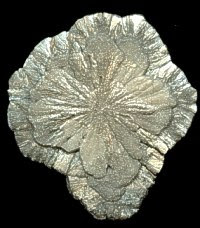 We recently visited our source for pyrite suns. He just got back from a trip where he picked up hundreds of them. We were blown away at this batch. The colors in the iridized ones were spectacular - unlike any I've ever seen before. I recently posted them in the Mosaic Rocks shop. Look for them starting at the bottom of the page.
We recently visited our source for pyrite suns. He just got back from a trip where he picked up hundreds of them. We were blown away at this batch. The colors in the iridized ones were spectacular - unlike any I've ever seen before. I recently posted them in the Mosaic Rocks shop. Look for them starting at the bottom of the page.One friend who received a few of these said:
"The pyrite suns came in yesterday. Bill, they are stunning. I was going to do some mosaic Christmas presents featuring them, but I’m not sure I can let them go. In the sun they shimmer in a thousand different colors."
No one really knows what these things are. Pyrite suns are found in one location in the world - a coal mine in Illinois.
People originally thought that these were some type of fossils. The current thinking is that they are pyrite crystals that grow in the seams of coal or shale layers. Since coal is so dense and hard, the crystals can only grow horizontally out. Here's a photo of how they look embedded in the shale.

The sun in the above photo has been cleaned. Usually, they come out of the ground looking something like this - only worse.
 Irina Charny sent this one to me. She purchased a number of uncleaned suns a while back. They came encrusted the dark mineral - probably coal or shale. She said she tried everything in the book to clean them up, spending hours scrubbing them. Eventually she discovered that Diet Coke worked best. Who would have thought? Imagine what that stuff does in your stomach.
Irina Charny sent this one to me. She purchased a number of uncleaned suns a while back. They came encrusted the dark mineral - probably coal or shale. She said she tried everything in the book to clean them up, spending hours scrubbing them. Eventually she discovered that Diet Coke worked best. Who would have thought? Imagine what that stuff does in your stomach.
 This is the other side of the same sun - the side she cleaned. Big difference!
This is the other side of the same sun - the side she cleaned. Big difference!
Now for the big mystery/secret. There are a few people who clean suns and then put them through some process to tint and/or iridize them. Apparently, this process is a well kept secret. The person who cleans the suns for our dealer told him that someone recently paid $10,000 to get the recipe. It's hard to imagine that it's worth it. I think pyrite suns are very reasonably priced given that they are so rare.
I expect that the silver ones are close to the natural color. Pyrite has a silver/gold color. Natural or not, these iridized ones are just spectacular. Here are some more photos of ones from Mosaic Rocks.



 Sonia King is the queen of pyrite suns and needs to be given credit for making them so popular in mosaics. If you haven't see her mosaics, check out the galleries on her website. I asked her if the tinted/iridized suns will lose color over time. She said she hasn't noticed any color loss over the years. Then again, her mosaics aren't that old.
Sonia King is the queen of pyrite suns and needs to be given credit for making them so popular in mosaics. If you haven't see her mosaics, check out the galleries on her website. I asked her if the tinted/iridized suns will lose color over time. She said she hasn't noticed any color loss over the years. Then again, her mosaics aren't that old.I expect that thousands of years from now when archaeologists are digging up our mosaics, they'll come across these suns and wonder why we used such colorless things in them. But for our lifetimes we can enjoy these magnificent colors.


No comments:
Post a Comment